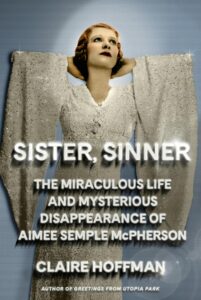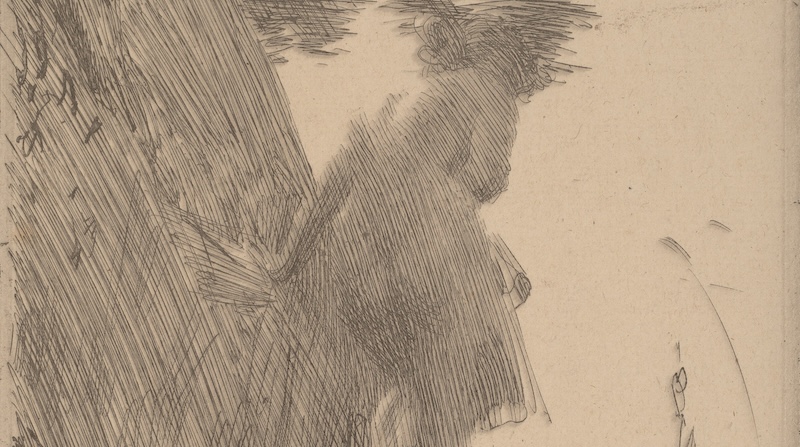For six years, I toggled between two worlds. By day, I was buried in microfiche, trial transcripts, and yellowing sermons, researching a biography of the long-dead evangelist Aimee Semple McPherson. At night, I turned to fiction—stories that felt like echoes of the one I was researching. They were about women coming undone. Women vanishing. Women, often in midlife, who looked around at the lives they’d carefully built and thought: I need to get out. I kept returning to one image: a discontented woman walking away from her life into the sea.
Article continues after advertisement
On a spring day in 1926, the most powerful woman in Los Angeles did just that—she walked down to the waters edge at Venice Beach and vanished. Aimee Semple McPherson was a world-famous preacher who could draw tens of thousands to her revivals, whose divine healings created mob scenes around the country. In the early 1920s, she built the country’s first megachurch and launched one of the first Christian radio stations. Her stated goal was to have a microphone so big the whole world would hear her gospel. Dorothy Parker saltily called her, Our Lady of the Loudspeaker. For that, and with equal ardor, she was adored by followers and reviled by critics. Then, on a sunny May afternoon, she swam into the water and disappeared.
On the sand, Aimee left behind a pile of cash, along with notes for that week’s sermon, entitled: Light and Darkness. When her assistant couldn’t find her, hysteria ensued. Boats trawled the bay, airplanes flew overhead. In the days to come, tens of thousands would hold a vigil for her, two people would die in the search effort, and special editions of newspapers were printed each day, fueling a collective obsession.
Thirty-six days later, at one o’clock in the morning, Aimee stumbled into a backyard on the Mexican border, more than 600 miles away from Venice Beach. She wore a white dress and corset, a pair of silken slippers and she begged not for water but for a telephone to call her mother.
Her reappearance ignited a media frenzy. In the months after her return, there was a grand jury trial and charges were filed against Aimee, her mother, her alleged lover and a schizophrenic doppelganger. But why would someone with so much power fabricate something so extreme? As details emerged that Aimee had perhaps run away for a romantic fling with a former employee—her radio operator—a larger question emerged: why would she do something so self-destructive? What would make someone—especially someone with so much to lose—explode their life in this way? And what would compel a woman already at the top of her world to believe her only option was to vanish from it?
That question didn’t stay in the past. For six years, I whirled through microfiche, hunched in basements reading trial transcripts and endless sermons, trying to understand the choices Aimee made. At the end of these long days, I stepped out of my research time machine and returned to my real life, in the 21st century, married, with two daughters, trying to navigate the spectrum of challenges that life threw my way. Over those years, I navigated family illnesses and death, moves, a pandemic, political upheaval and the churn of daily life. Like many, I tried to varying degrees to be the best person I could be according to the expectations of those around me—the healthiest, most attractive, emotionally conscious, socially aware partner, citizen, and mother possible. It was exhausting, it was wonderful.
As I toggled between past and present, I found escape at night in fiction. My bed stand was—and is—piled high with novels, an outlet to other worlds, other beings, other realities. Coming out of Aimee’s story, I started to notice echoes. The first place I saw it was in Kate Chopin’s 1899 classic novel, The Awakening. the godmother of these female midlife breakdown stories. The protagonist, Edna Pontellier—who at 28 is married with two young children and deeply enmeshed in New Orleans society—awakens into discontent with the world she lives in. She is drawn to a younger man in her midst, but the awakening is more meta—everything about the way she lives becomes unbearable. The book ends with Edna Pontellier swimming away from her life. She never comes back.
In the mesmerizing I Love You But I’ve Chosen Darkness, I floated down a desert river with Claire Vaye Watkins, as her narrator got high, connected with the desert, her truth, a young lover. She struggles with her success and in the end, leaves behind her life with her husband and baby girl. “I was doing the best I could with what I had,” wrote Watkins. “Or was I?” Last summer, like every other woman, I read All Fours. July’s narrator—who like Watkins draws much from her own life, finds herself stuck in Monrovia, orbiting the dead star of her youth, fixated on a hot young Hertz worker. “Also the rest of my life would be a slog and then I would die,” July’s narrator says when she fears rejection from her crush. “Which is the case for many people. It’s no big deal.” Middle age for July’s narrator has a dark history—both her grandmother and her aunt killed themselves in their 50s, both of them jumping from the same window. One put herself in a trash bag first to avoid a mess.
What would make someone—especially someone with so much to lose—explode their life in this way? And what would compel a woman already at the top of her world to believe her only option was to vanish from it?
I realized that over and over, I was inside stories of women who had built themselves lives that they were proud of and that they loved, and then started to burn them down. In literature, in life, I was seeing a kind of rebellion. I began to realize this wasn’t just a genre I was stumbling into—it was a shared language of discontent. These women wrestled with lust—for younger men, older women, and sometimes just an unfocused, all-over spray of desire for freedom. Like Clarissa Dalloway and Anna Karenina before them, each of these characters contend with the specter of their mothers, their partners and their expectations, with capitalism, feminism and parenthood.
In all these stories, they’re wrestling with their bodies, which have transformed into ticking time bombs, reminders that time is always slipping. But beyond the obvious stuff of midlife—the loss of youth, a sense of mortality—I noticed many of these characters struggle with the hollowness of the success they’ve finally achieved. In each of these novels, women find it so hard to exist honestly within power structures and ideology—even when they have helped create them. Maybe it’s no coincidence that these stories have exploded in the past few years, when so many women found themselves cracking under the weight of invisible labor, existential dread, and impossible expectations.
Aimee preached a fundamentalist lifestyle but found herself repeatedly challenged by that belief system. As she scratched out her notes for her Light and Darkness sermon, she seemed to be grappling with the simplistic binary ideology of good and evil, of saints and sinners. That day she perhaps recognized that she had spun a world she herself couldn’t comfortably live inside. But it turns out even escape has consequences.
It’s hard to know what hooks reeled Aimee back into her world and the power structures she had wanted to escape—her ministry, her mother, her children, her fans. But the pain of that choice was immediate and arguably it never stopped. She was punished. First through two legal proceedings, followed by years of extensive public humiliation. Aimee was picked apart—questioned about everything from her truthfulness and her faith, to her ankles, her hair and her love life. Sister, Sinner is my attempt to tell Aimee’s story in full. But Aimee’s tale—like these novels—is a case study in how difficult it is to be a complex, contradictory woman in a world that insists on clarity, compliance, and simplicity. Even when the systems we’re struggling against are the ones we helped build.
______________________________________________

Sister, Sinner: The Miraculous Life and Mysterious Disappearance of Aimee Semple McPherson by Claire Hoffman is available via Farrar, Straus & Giroux.
